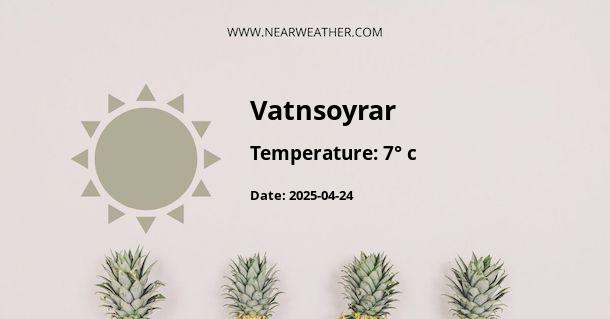Climate and Weather in Vatnsoyrar, Faroe Islands
Vatnsoyrar, located in the Faroe Islands, experiences a maritime subarctic climate. Situated in the North Atlantic Ocean between Norway and Iceland, the Faroe Islands are known for their rugged landscapes, dramatic cliffs, and unpredictable weather conditions. Vatnsoyrar, a small village in the Faroe Islands, shares many of these unique characteristics.Temperature
Vatnsoyrar has relatively cool temperatures throughout the year due to its northern latitude and the influence of the surrounding ocean. The average annual temperature in Vatnsoyrar ranges from 4 to 9 degrees Celsius (39 to 48 degrees Fahrenheit). The warmest months are July and August, with average high temperatures of around 12 to 14 degrees Celsius (54 to 57 degrees Fahrenheit). The coldest months are January and February, with average lows of approximately 1 to 2 degrees Celsius (34 to 36 degrees Fahrenheit).
Precipitation
Vatnsoyrar experiences a significant amount of precipitation throughout the year, with an average annual rainfall of about 1,500 to 2,000 millimeters (59 to 79 inches). The Faroe Islands are well-known for their cloudy and wet weather, and Vatnsoyrar is no exception. Rainfall is evenly distributed throughout the year, with no distinct dry season. The wettest months are typically October through January, with average monthly rainfall exceeding 150 millimeters (6 inches).
Wind
As an island location, Vatnsoyrar experiences frequent and strong winds. The Faroe Islands are known for their windy conditions, and Vatnsoyrar is exposed to the full force of the North Atlantic winds. Average wind speeds in Vatnsoyrar range from 9 to 15 meters per second (20 to 33 miles per hour), with gusts exceeding 20 meters per second (45 miles per hour) during storms. These strong winds can create challenging conditions for outdoor activities and transportation.
Sunlight
Due to its high latitude, Vatnsoyrar experiences significant variations in daylight hours throughout the year. In the summer months, Vatnsoyrar enjoys long days with extended periods of daylight. The longest day of the year, known as the summer solstice, occurs around June 21st, when the sun can stay above the horizon for more than 18 hours. In contrast, the winter months bring short days with limited sunlight. The shortest day of the year, known as the winter solstice, occurs around December 21st, when the sun can be below the horizon for more than 20 hours.
Fog
Fog is a common weather phenomenon in Vatnsoyrar and the Faroe Islands. The presence of warm ocean currents meeting colder air masses can lead to the formation of dense fog, especially along the coastlines and in the valleys. Foggy conditions can significantly reduce visibility and affect transportation and outdoor activities. It is important for residents and visitors to be prepared for foggy weather and take necessary precautions.
Climate Influences
Vatnsoyrar's climate is heavily influenced by the North Atlantic Ocean and the surrounding air currents. The Gulf Stream, a warm ocean current, helps moderate the temperatures in the Faroe Islands, preventing extreme cold in the winter and providing a relatively mild climate compared to other locations at similar latitudes. The Faroe Islands also experience frequent weather changes due to the interaction between warm and cold air masses, resulting in rapid shifts in weather conditions.
Recommended Clothing
Given the unpredictable weather in Vatnsoyrar, it is essential to pack appropriate clothing when visiting the area. It is advisable to bring waterproof and windproof outer layers, as well as layers of clothing that can be easily added or removed to adjust to changing temperatures. Sturdy footwear is also recommended for exploring the rugged terrain, as well as hats, gloves, and scarves for protection against the wind and cold. It is always better to be prepared for various weather conditions when venturing outdoors in Vatnsoyrar.
Conclusion
Vatnsoyrar, like the rest of the Faroe Islands, experiences a maritime subarctic climate characterized by cool temperatures, frequent precipitation, strong winds, and significant variations in daylight hours throughout the year. The unique geographical location of the Faroe Islands, surrounded by the North Atlantic Ocean, contributes to the distinct weather patterns observed in Vatnsoyrar. Visitors to Vatnsoyrar should be prepared for changing weather conditions and pack appropriate clothing to fully enjoy all that this beautiful and rugged region has to offer.
A - Vatnsoyrar's Latitude is 62.066669 & Longitude is -7.233330.
A - Weather in Vatnsoyrar is 7° today.
A - Climate Conditions in Vatnsoyrar shows overcast clouds today.
A - Humidity in Vatnsoyrar is 76% today.
A - Wind speed in Vatnsoyrar is 14.83 km/h, flowing at 350° wind direction. today.
